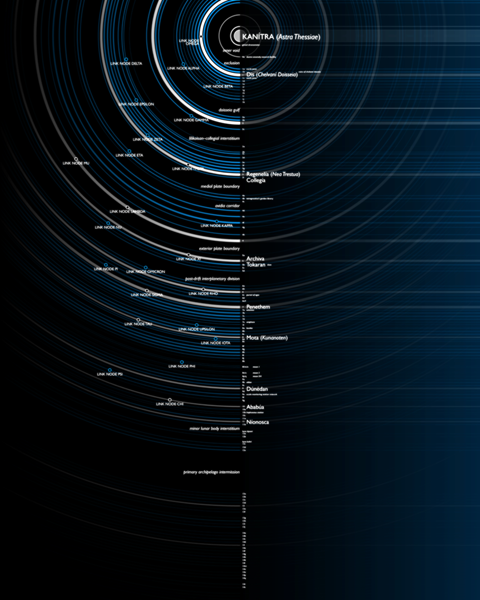
The Thessian Archipelago consists of a single white dwarf, known variously as Thessia, Astra Thessiae, Tra il Tetragnostika (the Eye of Tetragnostica), Kanítra, the Anomaly, or simply the Eye, surrounded by numerous rings of islands that orbit at various altitudes at a single angle. Because of the extremely thin manifold encasing the archipelago, interference from adjacent branes creates a significant gravitational pull of approximately 8.2 m/s² out of the solar plane (i.e., southward on the solar axis). The star itself and items with significant iron content that were present during the Shattering event remain suspended in a thaumomagnetic field; this includes the islands (remnants of Thessia Major and Minor and their moons), as well as several large artificial satellites.
The islands are broken up into distinct major and minor belts, each of which loosely shares an orbit. Major belts are denoted with a number, and minor belts are denoted with the nearest major belt's number, followed by a letter. Belts 1–8 originate from the Thessia Major planetary system, whereas belts 9–12 originate from the Thessia Minor planetary system. There are also two further belts, termed 13 and 14, which are too small to count as major belts but are numbered as such anyway. They consist primarily of minor debris and remnants of the Kedavevoyi asteroid formation.
As a general rule, average island size decreases in minor belts and in belts further away from the middle, although this is not always true. Major Belt 1 in particular has much smaller islands than the next inner three belts, because it consists primarily of fragments from the moons and is so close to the sun (with an average distance of less than 0.05 AU.) Because of the slow-time thaumic interaction in effect on the star, however, relatively little heat is emitted, and so even the innermost islands are habitable provided they have been equipped with suitable electrostatic shielding.